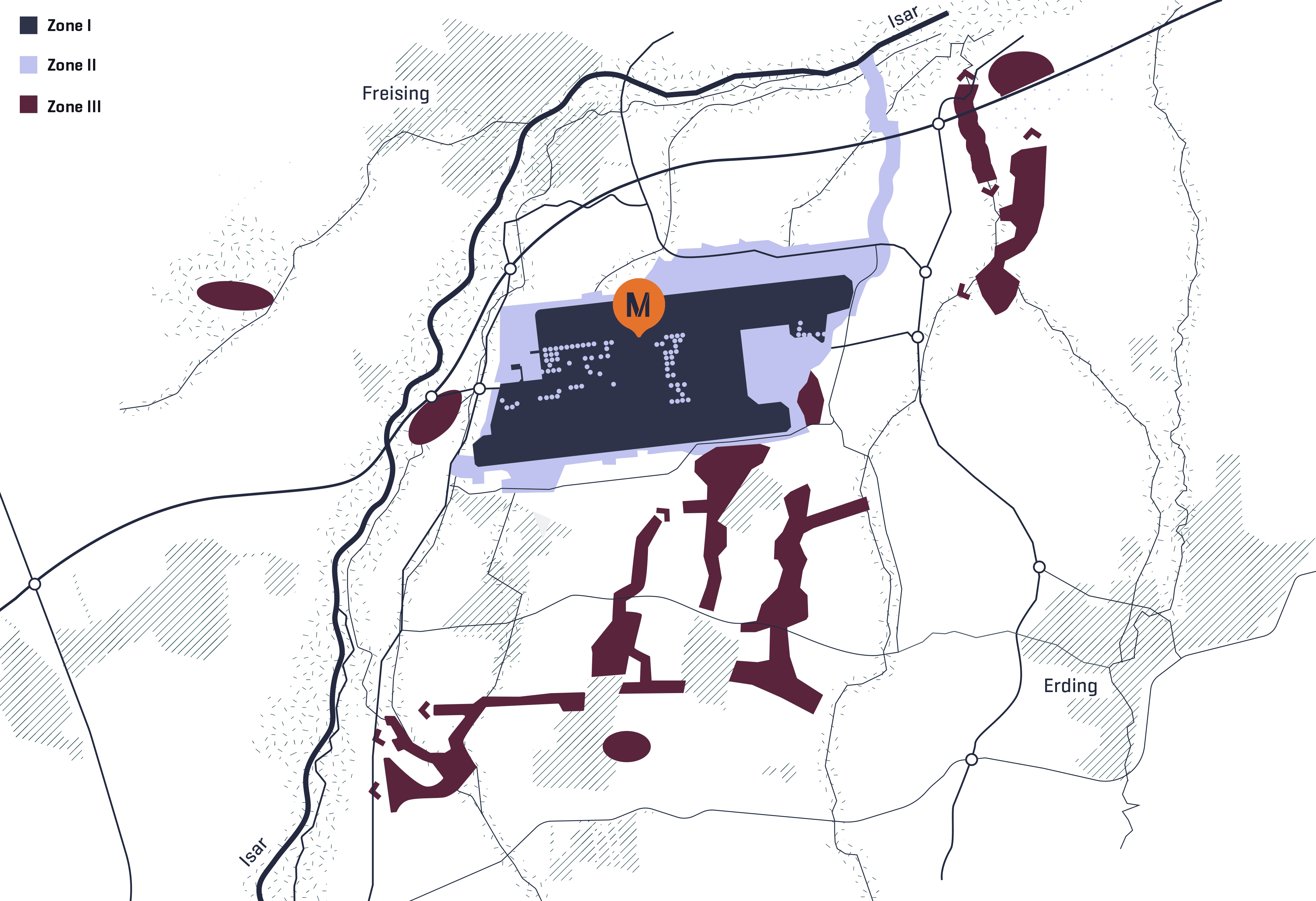Biodiversity
Three-zone concept: creating valuable habitats
To integrate Munich Airport into its environment in the best possible way, FMG created structures from the very outset that would ecologically upgrade the extensive surrounding area in the Erdinger and Freisinger Moos and link it together. For this purpose, a three-zone concept was implemented within the framework of the current green regulations: Zone I comprises the airport premises with runway system, buildings and roads, Zone II the wooded and structurally rich green belt around the airport premises and Zone III the ecological compensation measures.
zone model


Zone I: Airport grounds with runway system, buildings, and roads
Green areas, with currently around 5,000 planted trees, account for almost two-thirds of the airport grounds. Through targeted maintenance, species-rich vegetation and ecologically valuable habitats, especially for rare meadow breeders, have been created, notably within the security fence, on the green areas between the runways and their infrastructure facilities.
Zone II: Green belt rich in woodlands and structures around the airport grounds
The airport perimeter zone, with its woodlands, drainage ditches, and meadows, serves as a noise protection and buffer zone for settlements and agriculture. The northern pre-flood ditch with its near-natural course is home to protected plants such as pasqueflower, ox-eye daisy, perennial, and bellflower. The list of specially protected species includes the marsh gladiolus and the variegated pondweed.
Zone III: Ecological compensation measures
To date, FMG has planned and created around 530 hectares of compensation areas. They serve to compensate for the impact on nature and the landscape caused by construction projects. The responsible approval authorities confirmed that they were produced and maintained in accordance with the requirements. These nature conservation compensation areas contribute significantly to the region’s biodiversity with their richly structured and species-rich vegetation. They are distributed across the agricultural land and form retreats and stepping stones in the biotope network. They are neither fertilized nor treated with pesticides.
Habitats: compensating measures on the campus and in the surrounding area
FMG has created compensating measures for the grey partridge on the green islands along the southern ring road. So-called Benjes hedges made of deadwood provide protection for this native ground-nesting bird. In addition, several newly established areas – particularly in the Oberdingermoos – ecologically compensate for construction activities at the airport. Further ecological measures include sowing site-appropriate herbs, transferring mowing material from species-rich meadows, treating and removing topsoil, and removing shrubs.
Bird sanctuary: a home to endangered bird species
In August 2008, the 4,525-hectare EU bird sanctuary «Northern Erdinger Moos» was designated. Its centerpiece is the approximately 666-hectare area of airport meadows surrounding the two runways. In 2024, these meadows, as Bavaria’s most important breeding area for meadow birds, hosted 94 breeding pairs of the Eurasian curlew and 101 breeding territories of the lapwing. The critically endangered black-tailed godwit, of which only 19 breeding pairs remained across Bavaria in 2021, has also repeatedly bred on the airport meadows. In total, 40 bird species, some of them critically endangered, benefit from the high level of protection on and around Munich Airport grounds. Furthermore, in conjunction with the compensatory and replacement areas outside the airport premises, the airport serves as a refuge for rare plant species such as the creeping celery, reptiles such as the sand lizard, and insects such as the bird’s-eye damselfly.
Development of selected breeding bird species on the airport meadows


The lapwing was chosen as Bird of the Year 2024 because its habitat is being lost throughout Germany – including in the «Northern Erdinger Moos» bird sanctuary. However, the population trend on the airport meadows remains stable. These meadows provide the lapwing with a secure habitat and are considered, according to the Bavarian Environment Agency, the most important breeding area for lapwings in Upper Bavaria.
Compensating areas: grazing with a focus on conservation
In addition to the legal requirements, we also voluntarily support projects that promote biodiversity. One current example is the conservation-focused grazing project on a compensating area of the airport in the Freisinger Moos, which will start in 2025: Extensive land management involving grazing by Highland cattle is expected to have a positive impact on the population of meadow breeders.